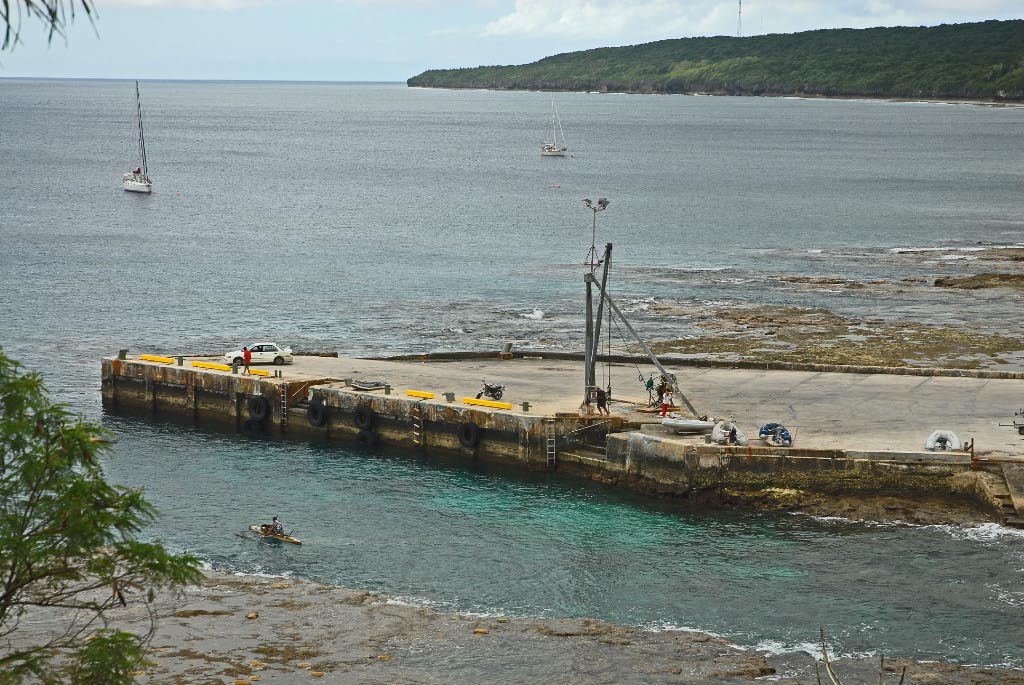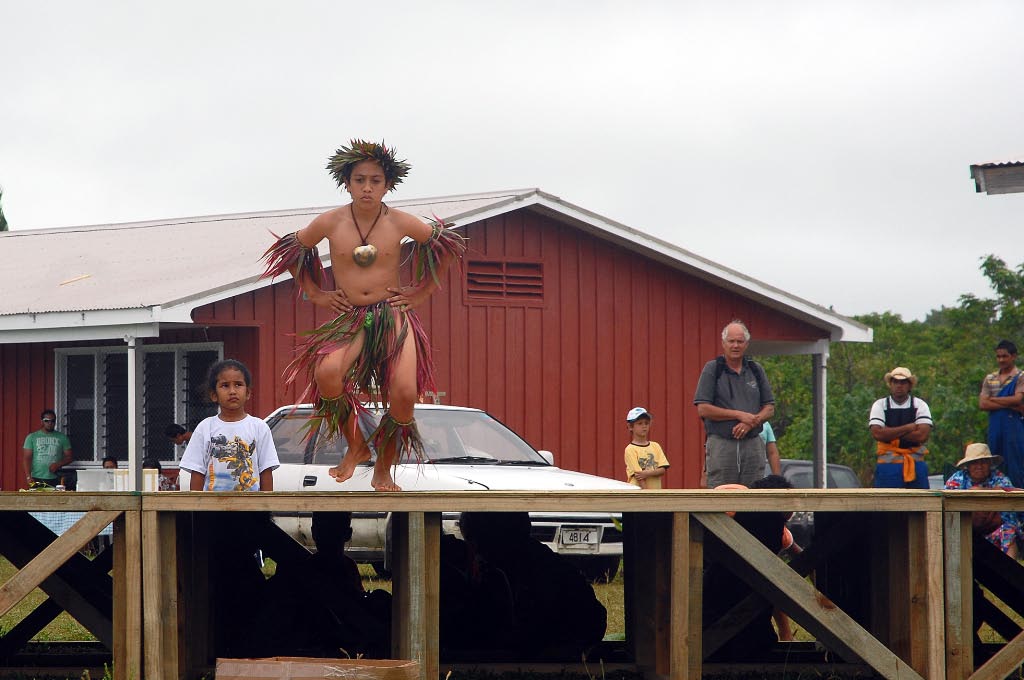As was forecast, the night before we arrived at Niue the barometer dropped and the wind turned to the northeast as a low pressure system passed through. When we approached the harbor around the south end of the island the wind begin to build, and when we rounded the last point of land we had 25 knots of wind on our nose and a foul current, making the last few miles of the approach take considerably longer than they should have. We called Radio Niue (pronounced NEW-way) to announce our arrival, and after that the Niue Yacht Club to request a buoy. The response from the yacht club was that as the low passes, the wind will clock around from the northeast back to the southeast and leave the bay exposed to westerly winds and swell. He said it would be very uncomfortable in here, and they would like to ask the yachts to move around to the other side of the island, but knew that was tough to sell. I had worried this would happen, and after a 9 day passage and with 25 knots of wind on my nose, just really wanted to get tied up to a buoy and have a rest.
We looked around and saw a dozen other boats sitting on the moorings not moving. When someone called to ask about the moorings and how strong they were, we were all assured that the moorings were fine, it was just that the swell entering the bay we be considerably “uncomfortable” for a while. That was an understatement, to say the least, but I’m glad to say it was only about 8 hours that we rolled toerail to toerail. Unfortunately the wind passes much faster than the swell and we were sideways to it by the time the biggest of the rollers were coming in. But by daybreak the next day it was comfortable again and we’re back to a southesterly breeze and gentle swell in the bay.
The moorings are in 65 feet of water, and as we got settled in and had a look over the side we were stunned at how clearly we could see the bottom with a completely overcast sky. The island has few sandy beaches and is basically a rock coming straight up out of 10,000 feet of water. The center of the island has a permeable crust that the rainwater seeps into, leaving little runoff and few streams to drain soil into the water. The result is truly crystal clear visibility – like looking through a glass of water from your kitchen faucet. We can’t wait to get in diving and have a look for ourselves.
 We stayed on the boat Friday and went ashore Saturday to check in with Customs. They won’t allow you to go anywhere else on the island until you’ve done your paperwork, so they first meet you at the pier. Since there is no harbor here you have to hoist your dinghy out of the water every time you go ashore. They have a hydraulic crane on the pier, so one person hops out and drops down the hook and operates the hoist, and the other hooks it up to a bridle in the dink and muscles it around onto a cart. Quite a system, but it seems to work.
We stayed on the boat Friday and went ashore Saturday to check in with Customs. They won’t allow you to go anywhere else on the island until you’ve done your paperwork, so they first meet you at the pier. Since there is no harbor here you have to hoist your dinghy out of the water every time you go ashore. They have a hydraulic crane on the pier, so one person hops out and drops down the hook and operates the hoist, and the other hooks it up to a bridle in the dink and muscles it around onto a cart. Quite a system, but it seems to work.

After we got checked in we went up to the high school, where they were having a “village day”. It consisted of food vendors and dancers, two things we always enjoy. When we arrived three older girls were performing traditional Polynesian dances and doing quite a lovely job. The next group was three “tweens” who were dancing hip-hop to Beyonce, followed by a couple dozen older women who were doing country-western line dancing to music that was neither Polynesian nor Country Western. Definitely different than the performances put on for the tourists, but fun to watch nevertheless. Our favorite was a young boy dressed in a traditional Cook Island / Polynesian grass costume, dancing solo – definitely the highlight of the festivities.
Sunday we were invited along to a cafe on the north shore where many of the Kiwis go for lunch. The guy in charge of the yacht club (Keith) and his wife who teaches math here took us and our friends from Nine of Cups along, showing us some beautiful spots on the island along the way. And yesterday Keith gave us a longer tour, taking us sightseeing for several hours in the afternoon. We were amazed to learn that when the cyclone hit here in 2004 the waves came up above the 30 meter shoreline. The bay where we are moored took a direct hit and with 300 kilometer per hour winds, the waves just kept stacking up on the hill until there was 2 meters of standing water on the hillside high above the bay. The damage was extensive, but they’ve cleaned up and rebuilt, even including many new houses right on the hillside where little was left behind after the cyclone passed by.
I don’t know how often Niue gets a supply ship, but what we do know is that the last on didn’t get here. It’s three weeks late and counting while the ship sits in Apia (Western Samoa) waiting for a repair part to arrive from Germany. I haven’t been to the grocery store yet, but my friend Marcy describes the pickings as “grim”. And unbelievably, she said prices are even worse than Bora Bora (7 dollars for a dozen eggs). Luckily we’ve got enough food to get us to Tonga so we don’t need much. The Kiwis are calling beer an endangered species, as the stores are out until the supply ship eventually arrives.
Now that we’re settled in we’ll contact the dive shop and make arrangements for some diving – both with them and without. We’re also planning to rent a car with our friends to see the spectacular chasms and sights of Niue, which I’ll report on later.
Today on Yohelah we’re enjoying Niue and looking forward to seeing more, both above and below the water….